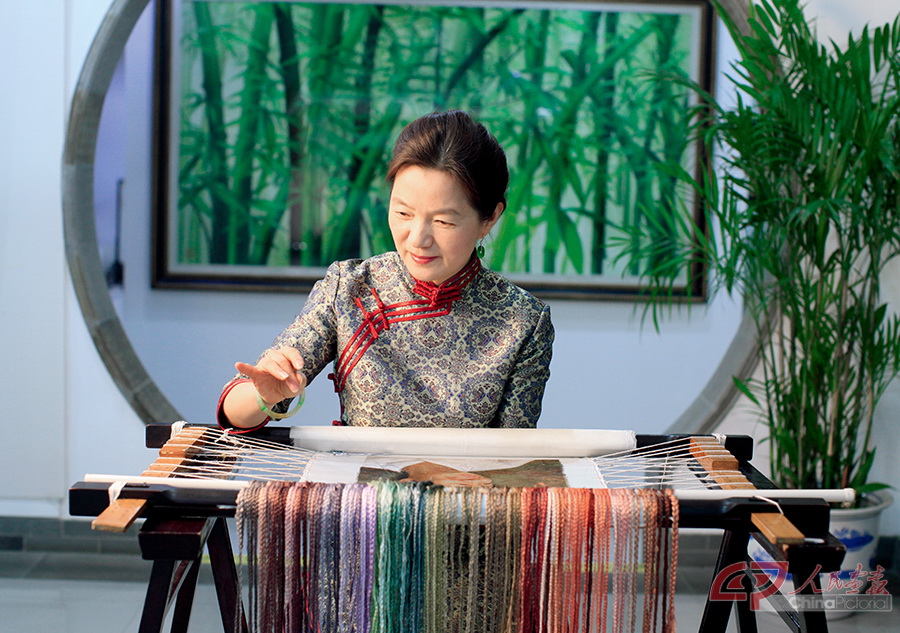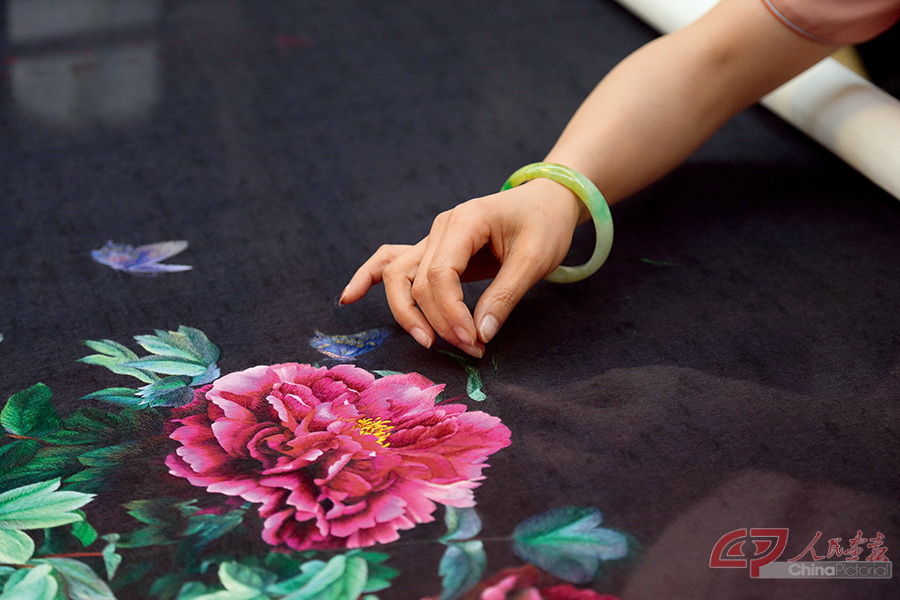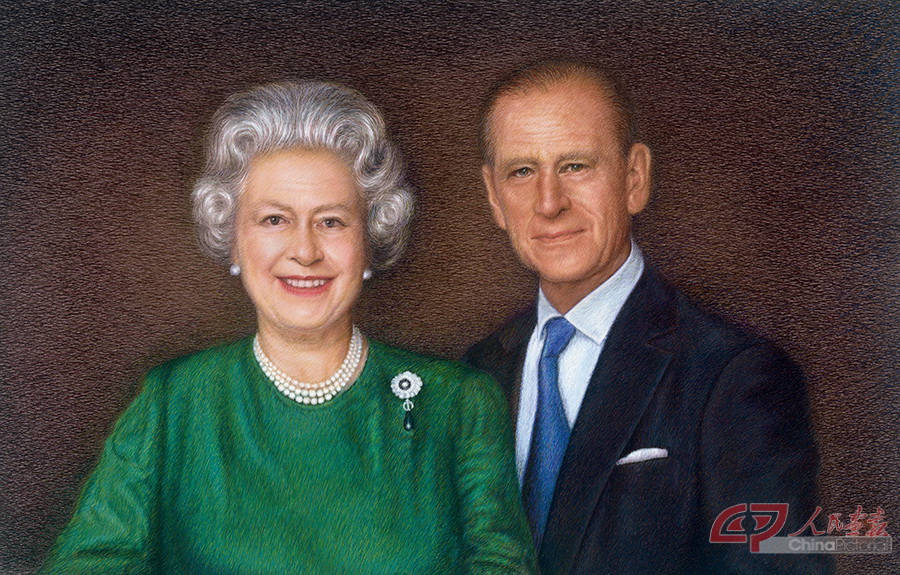
Yao Jianping [Yao Jianping]
"I feel truly obliged to be born and live in an era in which Su embroidery shines and embroiderers are given ample opportunities to bring out the best in them," Yao Jianping said.
Yao is a pretty embroiderer. The way she carries herself is graceful. Every movement she makes suggests feminine beauty, conforming with the image of a traditional southern Chinese lady. Born in 1967, she has maintained her slender shape quite well, which is a kind of beauty much appreciated in the country. On hearing that she will be interviewed, she put a pink dress on.
As an artist with a dexterous skill in embroidery, she dazzled us all with her delicate fingers, shining stitch when illustrating how to embroider. It wasn't until then that we realized embroidery could be such an amazing craft.

Yao embroiders. [rmhb.com]
Su embroidery tops China's four most renown embroidery. Zhenhu, a small county in east China's Jiangsu Province, is birth land of Su embroidery.
In the region, embroidery is an art that has been passed from generation to generation by female embroiders. The quality of it well represents the quality of a woman's family education.
Besides, embroidery in the region is far from being a mere tradition, it created an art miracle a hundred years ago. In 1911, a famous artist Shen Shou embroidered the portrait of the Queen of Italy, which was sent to Italy as a national present.
National Present
Yao's studio is located in this area. It's a three-story building and the first and second floors are used to exhibit her work. She works on the third floor.
Now, over 40 embroiderers work together with her. She is one of the representative inheritors of China's intangible cultural heritage so her studio attracts many visitors every day, and she often explains each work by herself.
She has since been well known because her work was also sent to other foreign countries as a national present.

Yao's embroidery 'Silk Road' [rmhb.com]
On October 20, 2015, Queen Elizabeth II accepted a Chinese embroidery from President Xi Jinping and his wife Peng Liyuan at Buckingham Palace. The art piece, named “song of life”, depicts a smiling picture of Queen Elizabeth II and her husband Prince Philip. It is 1.18 meters long and took three months for Yao Jianping and her four assistants to complete.
This is not the first time that Yao created portrait for Queen Elizabeth II. Early in June 2012, Yao's embroidery work "The Queen" became part of an official collection at Buckingham Palace on the 60th anniversary of the accession of Queen Elizabeth II.
Find a Teacher
Yao was born in a village called Xinsheng. She started to learn embroidery when she was about seven or eight years old. She was seen as a talented embroiderer when she was a teenager. Her fine work has always won her great compliments by others.
Early in the 1980s, local embroiders took their work to sell in downtown Suzhou, and some even took their works out of the province to sell. Gradually, they earned customers who even came to their homes to buy embroidery.
In 1990, when everyone else was selling their embroidery, Yao, who was married by then, decided to find a teacher to learn the art. Many people, including her family, could not understand her. Retrospectively, she says, "Even though people always complimented my work and I could earn three times more than regular embroiderers, I didn't think that was good enough, and I was eager to reach a higher level. I wanted to learn more."

Yao's embroidery 'Song of Life' [rmhb.com]
At that time, even though there were institutes that studied embroidery specifically, it was nearly impossible to find a teacher as it wasn't allowed for anyone to establish a private school or to give private classes. Despite the difficulties, Yao managed to find a retired teacher with the aid of a friend.
The teacher was Xu Zhihui. She was exhilarated, but the teacher wouldn't accept her at first, thinking that she was like other girls who lack perseverance. But Yao insisted. She even proposed that that she could stay at the teacher's home and do all her chores. The teacher was touched by her honesty and said yes.
Not only was Yao quick at learning, but she was also hard at it. She stayed with the teacher for as long as four years and ended up grasping the best part of the craft under the guidance of the teacher.
Determination
The year of 1998 is an important year for Su embroidery, as it was when it gained popularity overnight. The government even gathered all works in a street to promote the craft. Very soon, the county became a famous place for embroidery. In 2002, the sales amounted to 300 million. However, Yao chose not to take part in such business, and started a studio on her own instead.
"Indeed, the embroidery business flourished, and I could have earned a lot if I'd started a store at that time, but I didn't want to waste my craft because I was determined to be an artist." Yao believed that it was her time. "I'm going to create works that belong to our age." She knew it was hard, and it was even harder to develop her own style as she could only borrow from the traditional crafts. If she really wanted to create something of her own, there was too much to learn from. It was most probable that people might not understand her, but she was determined. She worried about embroiders on the market because all of them were similar. She wanted to make something different.
"Instead of copying pictures, I created them," she said.
The Embroidery Studio
There are many students in Yao's studio for now, and these students have studied here for well over 10 years.
She makes it a rule to analyze each embroidery in person and guide her students in a meticulous way. Once her analysis is finished, she will pick students to do the job and allocate their tasks. She always does her upmost to get the best picture and helps perfect the works. Her group is particularly good at making large pictures.
It is difficult to learn how to embroider, but teaching others is just as hard. However, the most difficult part for Yao is attracting young people to learn this craft. Today, many young people find it too hard to learn.
"People can make huge progress after three years, but seldom can anyone persist that long. Many give up halfway," Yao said. In order to find an inheritor of the art, she persuaded her daughter to do it.
"It was the government that promoted development of this traditional craft. It is time that provided us with such an opportunity," Yao said. There are still many people who do not understand her choice even today, but she is determined to exert all her efforts to promote the art.

